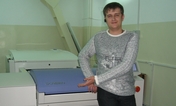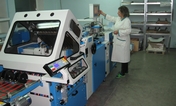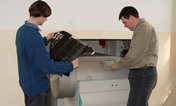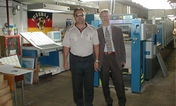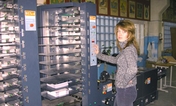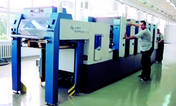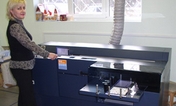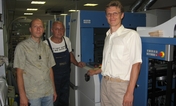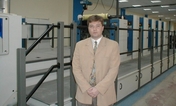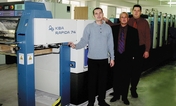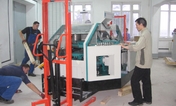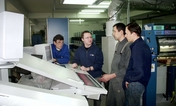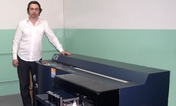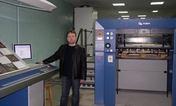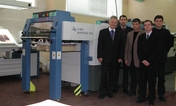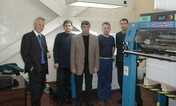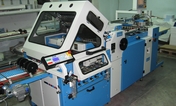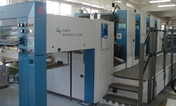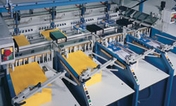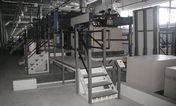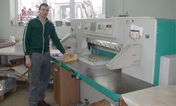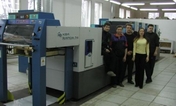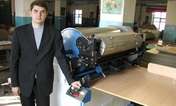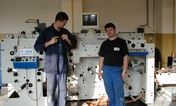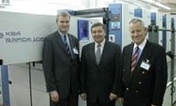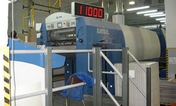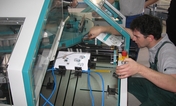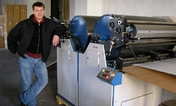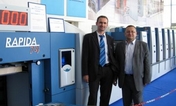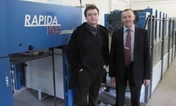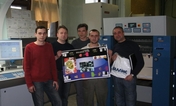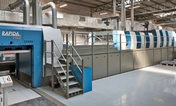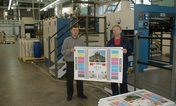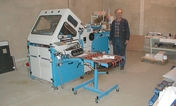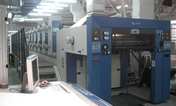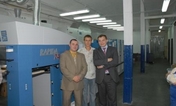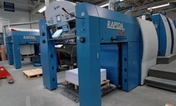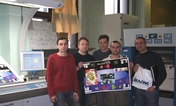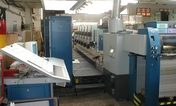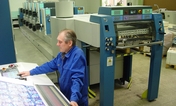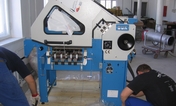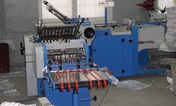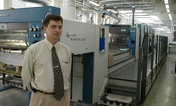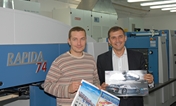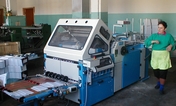At last year’s Drupa KBA unveiled the Rapida 145 press series which offers outstanding performance in large format. The new KBA Rapida 164, available since the beginning of this year, also supersedes the vastly successful Rapida 162.
The Rapida 164 was officially showcased as part of an open house at KBA in Radebeul on 20 and 21 June. Over 300 existing and potential users of large-format sheetfed offset presses from over 15 predominantly European countries came to the Elbe valley in Saxony to view first-hand the new standard of performance in this format class and the great advances in process automation, makeready times and productivity for increasingly shorter runs.
Equipped for the production of packaging, a plinth-mounted six-colour Rapida 164 with coater and extended delivery was the focus of live demonstrations. Jurgen Veil, head of sheetfed marketing, introduced the automation components and presented the print demonstrations. The new Rapida 164 redefines the benchmarks in the 120.5 x 164cm (47.4 x 64.57in) format class. Thanks to dedicated drive technology and a high level of automation, time consuming manual adjustments are no longer required at the feeder. The press runs at a maximum output of 15,000sph simply by pressing two buttons.
Like the Rapida 145, the Rapida 164 is equipped with DriveTronic SIS sidelay-free infeed. Along with automatic plate changing, there is also the option of DriveTronic SPC dedicated drives at the plate cylinders that support simultaneous plate changes in all printing units in only 100 seconds. Further makeready processes, such as washing with CleanTronic Synchro, are also possible in parallel. Similar to medium-format presses, when changing plates KBA Plate-Ident carries out on-press plate recognition, pre-registration and checks that the plates are correctly positioned. Even coating formes can be changed automatically while the press is printing, as can anilox roller sleeves. The high-flow doctor-blade chamber with a reduced filling volume is also a new feature.
The increased speed at which the ink flows supports faster production speeds and optimised sheet brakes for commercial and packaging printing ensure an outstanding pile formation. Further new features found in the Rapida 164 include the AirTronic delivery, energy-saving VariDryBlue drying systems and the new ErgoTronic console with integrated measuring systems. [for more information see press release 13-013 from 19.2.2013].
Simultaneous printing and makeready
The visitors then saw an everyday job change. The printing plates were mounted with DriveTronic SPC and after the first proof density measurements and colour register were checked. In less than four minutes the Rapida 164 produced a typical packaging job. Blue and silver were used in the fifth and sixth printing units as special inks.
The following job change was really something special. Printing units one and two plus the coater were uncoupled during plate changing and blanket washing. The ink ducts were washed and the coating was pumped out likewise in parallel. In less than three minutes the first proof of the next job could be seen. Following register and density measurements, within five minutes a four-colour packaging job had started.
While the press carried on printing at full speed, coating continued to be pumped out and anilox roller sleeves were changed in preparation for the next job. After the press was stopped, plate changes, blanket washing, coating forme changes and filling the doctor-blade chamber with new coating all took place simultaneously in under two minutes. Then the coater and printing units one and two were reconnected and after about six minutes the Rapida 164 was printing the next job. A world first in large format then rounded-off the demonstrations with the Flying JobChange between the first and sixth printing unit.
Speciality from Radebeul: UV inert drying in sheetfed offset
Along with the live press demonstrations, Jurgen Veil introduced the new VariDry UV dryer made and developed entirely by KBA. It is particularly energy efficient thanks to cutting-edge reflectors and less distance between lamps and substrate. Further benefits include a reduction in diffused light, UV radiation and the build-up of heat. The efficiency of UV lamps is continuously checked as UV output is measured directly on the lamp by a sensor. Lamps can be exchanged in just a few seconds by hand.
Along with classic UV dryers, KBA also offers UV inert dryers for medium- and large-format Rapidas as a speciality. These offer enhanced crosslinking as well as fewer risks in terms of migration and odour if the consumables are tailored to the conditions in the inert chamber. A short time ago in sheetfed offset it was not possible to create a stable nitrogen barrier. Reasons for this were the gripper system, the open cylinder gap and the large distance between the printing cylinder and inert chamber, plus rigid substrates coming into contact with the inert chamber. KBA has solved this problem with its new AirTronic Drum suction cylinder. Mr Veil used the example of the 19-unit Rapida 106 with inert equipment at Amcor Tobacco Packaging in Rickenbach, Switzerland when explaining the process. Along with an outstanding print and finishing quality, it also eliminates the need for additional process steps in producing high-quality migration-sensitive packaging.
A further presentation focused on calculating the output of a press according to OEE (Overall Equipment Effectiveness). Press efficiency is determined by three factors: availability, performance and quality.
Highlights in all format classes
Along with the official premiere of the Rapida 164, participants were treated to presentations on six other sheetfed presses from half-size to large format. The spectrum ranged from packaging production on a Rapida 75 up to commercial production with fast job changes on a Rapida 145.
Highlights included: printing cosmetic packaging on a brand-new Rapida 76 equipped with almost all automation options found in the Rapida 106, such as DriveTronic SIS and DriveTronic SPC, 4/4-colour high-speed commercial production including fast job changing on a ten-colour Rapida 106, producing commercial jobs on a six-colour Rapida 145 with coater at speeds of up to 17,000sph, printing at 20,000 sph with inline colour control according to grey balance with InstrumentFlight from System Brunner on a five-colour Rapida 106 and last but not least producing intricately finished packaging on a double-coater Rapida 106 with inline cold foil finishing (KBA ColdFoiler).
In addition, for the first time KBA showcased four-back-four production on an eight-colour Rapida 105 with HR UV dryers. Overall the international sheetfed offset experts gained an insight into the high standard of printing and finishing technology inside the KBA Rapidas in all format classes.
The guests enjoyed an evening steam boat river cruise on the Elbe with views of the baroque old town and the Elbe palaces nearby. Thankfully water levels have returned to normal after this year’s serious flooding affecting the region and luckily Dresden was not as badly affected as it was in 2002.

